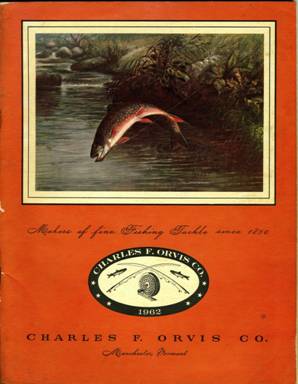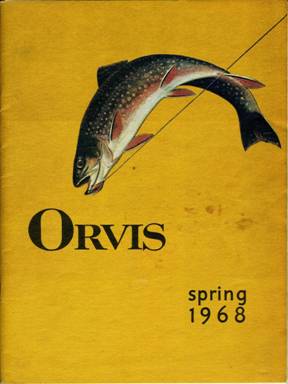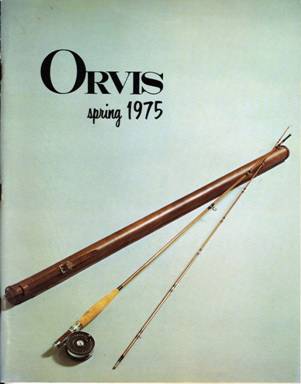REFLECTIONS
I presume that age has something to do with it but I increasing find myself looking back and reflecting upon where we've been and wondering where we're going. I've lived through the renaissance of fly fishing from the late 50's to the present. Recently I pulled several old fly fishing catalogues from my bookcase and sat out under the trees in my lawn and looked back at the history of fly fishing equipment from my past.

My oldest catalogue is from Charles F. Orvis Co which I received in 1962. It still had the traditional jumping brook trout painting on the front cover and there was a note inside asking "What happened to the Dropper Fly?" Apparently the image was originally commissioned by Charles F. Orvis, the founder of the Orvis Company. On the cover of this catalogue they used the original lithograph and the dropper fly, which had been evident in the previous copies, is missing. Ah, the mysteries that we find in fly fishing.
Flipping through the catalogue I noted that most all the fly rods that they offered for sale were made of bamboo. The top of the line was the Battenkill, and you could pick one up for the outrageous price of ninety-eight dollars and fifty cents. That was a two-piece bamboo rod with an extra tip in a poplin cloth sack and an aluminum case, and that included shipping! The most expensive rods in the catalogue were the salmon rods, and you could purchase a fourteen and a half foot, 3 piece, two-handed bamboo salmon rod for one hundred ninety dollars, with two tips, poplin cloth sack and aluminum case. They even offered a bamboo bait casting rod for fifty-two dollars and fifty cents or sixty-two dollars and fifty cents, depending on whether you wanted an offset or straight handle. They did offer 4 fiberglass rods called Orvisco Glass Fly Rods and ranged in price from sixty-five dollars to seventy-five dollars.
What intrigued me the most was the fly selection. There was a small selection of midge patterns which were just small versions of standard dry flies, and most of the trout flies were offered in sizes from 8's to 16's and the smallest flies in the catalogue were Marinaro's Jassids in size 20.

Fast forward six years to 1968 and the front of the catalogue featured a brook trout without the rest of the picture. Inside bamboo fly rods were still prominent but now there were ten fiberglass rods, and the price of the Orvis Battenkill bamboo rod had increased to one hundred thirty-five dollars plus shipping and handling. The two handed bamboo salmon rods were no longer offered in the catalogue and the bamboo bait casting rod had disappeared. They were still offering silk fly lines. The fly selection had increased and they had several small midge flies and nymphs down to size 22.

The 1975 catalogue introduced the new rod material, Graphite, and I believe it marked the end of the dominance of bamboo in the history of the Orvis Company. The catalogue was in full color and while the traditional bamboo rods still filled the first pages of the catalogue the new graphite fly rods were prominently featured on pages 14 and 15. They even offered an Atlantic salmon graphite rod. They featured graphite rods on the back page of the catalogue. There were far more flies, from an enlarged offering of terrestrials and a selection of midges down to size 28. There were "new polywing spinners" and a selection of no-hackle flies. The fly tying materials and tools took up six pages. Orvis no longer offered silk fly lines.
It has been several years since I received an Orvis catalogue in the mail but I checked their website and discovered that they currently only carry two bamboo rods, and they will set you back over two thousand dollars apiece plus shipping and handling. They offer all kinds of rods from traditional trout rods, salt water models, two handed, switch and, the latest addition, Tenkara. The fly selection includes flies for carp, salt water, traditional trout flies and a selection of bead head nymphs. They indicate that they have five hundred and ninety fly patterns. The fly tying section is impressive.
While the current offerings are imposing there is something in me that yearns for the simplicity of those early Orvis catalogues and the times that they represent.
